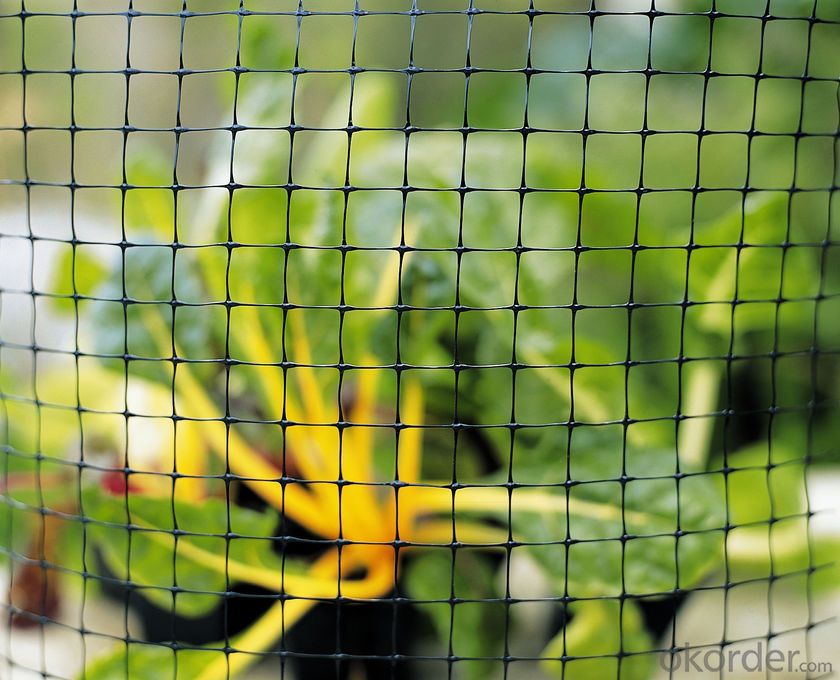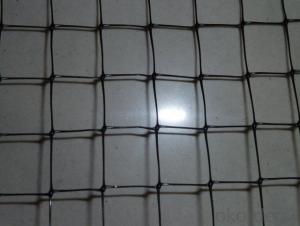Deer Guard Fence, Extruded PP Deer Guard Netting
- Loading Port:
- China main port
- Payment Terms:
- TT OR LC
- Min Order Qty:
- 5000 m²
- Supply Capability:
- 1000000 m²/month
OKorder Service Pledge
OKorder Financial Service
You Might Also Like
Plastic netting plastic mesh breeding mesh
1. Plastic Plain Netting
Colour:white,black,blue and green, client's requirement.

2. Deer fence introduction:
Deer fencing is a very high strength, lightweight, 3.6ft to 7.3ft high deer fence manufactured from high strength polypropylene BOP plastic netting. Deer have a tendency to forage over large areas and the cost effective deer fencing offers a very effective deer control barrier.
The deer fence is black, UV stabilised and rot proof and unobtrusive as it merges into it's background. Deer fencing is very quick and easy to erect and each roll weighs less than 15kg. The Deer Netting should be installed by battening to the fencing posts to ensure the mesh filaments are not damaged.
3. Features of the deer neeting fence:
Deer fence is easy to erect and install
Plastic netting has a mesh hole size of 0.06" ,0.08",0.18",0.19"
The BOP plastic netting has a high tensile strength
Plastic mesh is UV stabilized and chemical resistant
Deer fencing rolls are lightweight
Deer fencing is a very high strength, lightweight 1.8m high Deer fence manufactured from polypropylene.
Deer fencing net is supplied on a 100m long roll
4. Features:
1). Low cost, while has superior strength
2). Has anti-tearing and friction capability
3). Wide range of product availability, some other mesh sizes and weights can also produced as per customers' requirements.
5. Package/Payment/Delivery:
Package: Usually packed by rolls in plastic film bags with labels inside and then loosely loaded in the container
6. FAQ:
Q1: What is your minimum order quantity?
A:The minimum order quantity is 5000 ,but it is negotiable.
Q2:What is your payment terms?
A: T/T,Western Union,Paypal,L/C...
Q3:What is your delivery time?
A:Production time usually costs 2-20 days.
Waiting to cooperate with you!
- Q:What are the limitations of using geotextiles in high-water flow conditions?
- One limitation of using geotextiles in high-water flow conditions is their potential to clog and become less effective over time. The continuous exposure to flowing water can lead to the accumulation of sediments and other debris, which can reduce the permeability of the geotextile and hinder its ability to drain water efficiently. Additionally, in extreme high-flow situations, geotextiles may not provide sufficient strength and stability to withstand the forces exerted by the water, potentially leading to failure or damage. Therefore, careful consideration and proper design are essential when using geotextiles in high-water flow conditions.
- Q:How do geotextiles help in filtration?
- Geotextiles help in filtration by acting as a barrier that allows water to pass through while preventing the passage of fine particles and sediments, effectively filtering the water.
- Q:What are the standards and regulations governing geotextiles?
- Geotextiles are governed by various standards and regulations to ensure their quality, performance, and safety. Some of the key standards include ASTM D4355, which defines the classification system for geotextiles based on their functions and characteristics, and ASTM D4595, which specifies the test methods for determining the properties of geotextiles. Additionally, regulations such as the American Association of State Highway and Transportation Officials (AASHTO) and the Federal Highway Administration (FHWA) provide guidelines for the use of geotextiles in transportation projects. These standards and regulations aim to promote consistency, reliability, and effectiveness in the use of geotextiles for various applications.
- Q:Can geotextiles be used for reinforcement of embankments?
- Yes, geotextiles can be used for reinforcement of embankments. Geotextiles are commonly used as a separation, filtration, and reinforcement material in civil engineering applications. They can be placed between the soil layers to improve stability, prevent soil erosion, and enhance the overall strength of embankments.
- Q:What are the types of geogrids?
- Geogrid type is a lot of it, steel-plastic geogrid / convex knot steel-plastic geogrid / overall plastic geogrid / fiberglass geogrid, etc.
- Q:What are the applications of geotextiles?
- Geotextiles have various applications in civil engineering and construction projects. They are commonly used for soil stabilization, erosion control, filtration, drainage, and reinforcement purposes. Geotextiles can be found in road and railway construction, landfills, coastal protection, retaining walls, and even in agriculture for weed control and soil improvement.
- Q:How do geotextiles affect wildlife habitats?
- Geotextiles can have both positive and negative effects on wildlife habitats. On one hand, they can be used to protect and restore ecosystems by preventing soil erosion, stabilizing slopes, and controlling sedimentation. This can create favorable conditions for wildlife by preserving natural habitats and preventing habitat loss. On the other hand, improper installation or use of geotextiles can disrupt natural processes, such as water flow, and alter the composition of habitats. Therefore, it is crucial to consider the specific application and environmental context when assessing the impact of geotextiles on wildlife habitats.
- Q:How do geotextiles help with erosion control in riverbanks?
- Geotextiles help with erosion control in riverbanks by providing a protective barrier that prevents soil erosion, while allowing water to flow through. They stabilize the soil, preventing it from being washed away by the force of the water, and also promote the growth of vegetation, which further helps to anchor the soil and protect against erosion.
- Q:How do geotextiles compare to traditional construction materials?
- Geotextiles are an innovative alternative to traditional construction materials. Unlike traditional materials such as concrete or asphalt, geotextiles offer numerous advantages. They are lightweight, easy to install, and highly flexible, allowing for efficient and cost-effective construction. Geotextiles also provide excellent erosion control, soil stabilization, and drainage capabilities. Furthermore, they are environmentally friendly, as they allow for natural filtration and groundwater recharge. Overall, geotextiles surpass traditional construction materials in terms of versatility, durability, and sustainability.
- Q:Who knows geotextile, how to sew, the best video
- Sewing machine can be sewn, you can also use hot air gun hot melt, I am specializing in the production of geotechnical materials
1. Manufacturer Overview |
|
|---|---|
| Location | |
| Year Established | |
| Annual Output Value | |
| Main Markets | |
| Company Certifications | |
2. Manufacturer Certificates |
|
|---|---|
| a) Certification Name | |
| Range | |
| Reference | |
| Validity Period | |
3. Manufacturer Capability |
|
|---|---|
| a)Trade Capacity | |
| Nearest Port | |
| Export Percentage | |
| No.of Employees in Trade Department | |
| Language Spoken: | |
| b)Factory Information | |
| Factory Size: | |
| No. of Production Lines | |
| Contract Manufacturing | |
| Product Price Range | |
Send your message to us
Deer Guard Fence, Extruded PP Deer Guard Netting
- Loading Port:
- China main port
- Payment Terms:
- TT OR LC
- Min Order Qty:
- 5000 m²
- Supply Capability:
- 1000000 m²/month
OKorder Service Pledge
OKorder Financial Service
Similar products
New products
Hot products
Related keywords

































